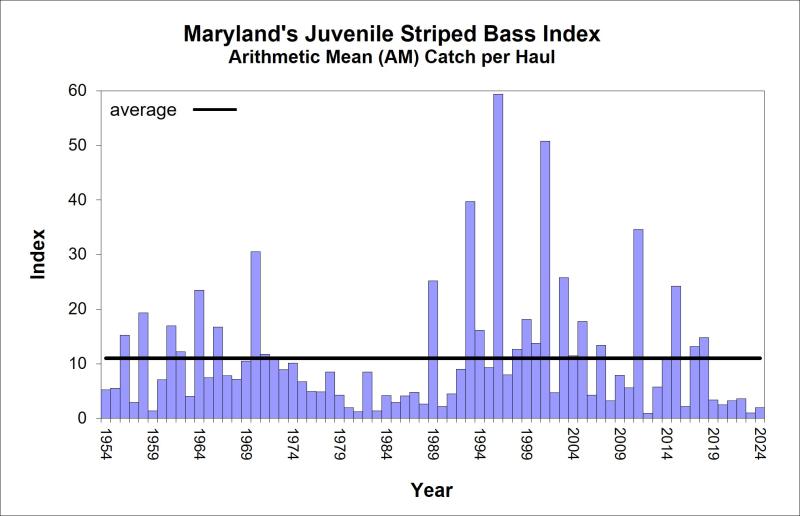More bad news about striped bass
The Maryland Young of the Year Striped Bass Index for 2024 has been announced, and once again it is well below the average for the past 60 years. That average is 11; in 2024, the average was 2. That is slightly above the 2023 average of 1, but it extends the run of below YOY averages to six years.
Beginning in 1971 and running until 1989, we had 17 years of below-average YOY results, yet we kept on catching stripers.
During this time, I had a tent that my wife Barbara and I used at the southside campground at Indian River Inlet. One week, we took vacation and it rained all week. Bill Steen and his wife were camped in their truck camper alongside us, and one day he asked me to go fishing with him.
We went out on his cousin’s boat, a wood craft without a deck in the stern.
We trolled Tony 141 spoons, and we had rockfish schooled up across from Oak Orchard and we were bailing them. Finally, we just stopped and cast to the school. It was a ball!
We threw the fish to the stern, which was full of water from the rain, and then ran with the plug out to drain it when it got too full.
Beginning in the mid-‘70s, a group was formed, the State-Federal Striped Bass Management Committee, with members from every state from Maine to North Carolina. I was Delaware’s recreational fishing representative. There was one commercial, one recreational and one state fisheries representative from each state. We were charged with solving the lack of striped bass in the wild. World peace was next on the agenda.
It should come as no surprise that each section of the region blamed the other section for killing too many stripers. The boys up north blamed us for killing too many small fish, and we blamed the Yankees for killing too many big fish.
And then there was Virginia. The commonwealth had an oblivious dead or injured law that pretty much said you could keep anything you caught, be it with a net, fishhook, speargun or anything that injured the fish. In other words, the laws that governed fishing were worthless as the paper they were written on.
Our first meeting was in Salisbury, Md., and after the meeting, we all went out to dinner. The waitress said there was a menu correction because they were out of rockfish. The table erupted in laughter.
After the first meeting, it was decided to have our meetings in Connecticut. We discovered that the Atlantic States Marine Fisheries Commission, which is responsible for fisheries regulations inside the Three-Mile-Limit, had no enforcement powers. In other words, the ASMFC could write all the regulations it wanted, and the states could go right on ignoring them without fear of reprisals.
A U.S. senator – I believe he was from Connecticut – introduced a bill that gave the ASMFC the power to close any fishery it regulated if the state did not abide by that regulation.
And still the YOY was dismal.
This is when the idea of a moratorium first began to gain support. Some of us thought the only way to save the striped bass was to stop killing striped bass. Others disagreed. The Chesapeake Bay commercial fishermen and the Chesapeake Bay Foundation were the two biggest opponents. The watermen hired a biologist who said there were plenty of striped bass in the bay, just like he was paid to do. They also built an office on Smith Island for the Chesapeake Bay Foundation.
Fortunately, Gov. Hughes put a moratorium on striped bass in Maryland; Delaware followed suit the next day. The CBF finally decided to follow the science instead of the money, and shortly thereafter, there was a terrible fire on Smith Island and the CBF office was just a pile of ash. I shouldn’t have to tell you what commonwealth was last to place a moratorium on striped bass.
The moratorium lasted until Gov. Schaffer, who was a friend of the watermen, added Hambrooks Bar to the list of sites sampled in the YOY and lo and behold, we had enough YOY to open the striped bass fishing.
That was the late 1980s, and I was living in Virginia Beach. The striped bass fishing was pretty good. I could go to the Chesapeake Bay Bridge-Tunnel early in the morning and catch my two-fish limit on bucktails. Then larger stripers began to show up around the 12-Mile Marker and they too went for bucktails. Finally, we had big stripers, well over 36 inches, following whales and menhaden in the ocean well inside the Three-Mile-Limit. We caught them by trolling MOJOs or big spoons.
Now we have a one-fish slot between 28 and 31 inches.


















































